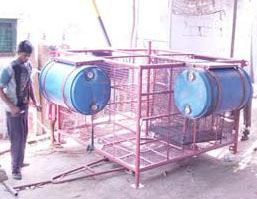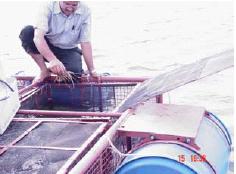|
Fattening in cages
Site selection
The site should be easily approachable, less prone to natural calamities and pollution
and should be comparatively calm. The intensity of fishing activities should be
less. The seabed should be suitable for anchoring the cages. The availability of
juvenile lobsters and natural feeds such as clams, trash fishes and crabs renders
the site more suitable.
Cage Design
The cage has a main frame made of 2 1/2 inch diameter GI Pipe with steel woven mesh
(2 x 2 x 1.2m) and accommodated four inner cages (0.75 x 0.75 x 1.1m) with two layers
of nylon mesh with sizes 15mm x 15mm (inner) and 5mm x 5mm (outer). A lifting arrangement
with pulleys was provided for handing these inner cages at site. The metallic body
was painted with nontoxic, food grade eco - friendly, polymer based paint with antifouling
property. The second stage of cage development the inner cage volume was increased
to 1 m3.
Stocking
Juveniles collected as by-catch can be stocked at a density of 25-30/m2.
Initial body weight and carapace length of the individual lobsters should be recorded
to assess the growth performance and feed requirement.
|

Lobster cage
|

Stocking in cage
|
Feeding
The spiny lobster is a selective feeder, preferring shellfish to scale fish. Mussels,
clams, squids, trash fish etc. could be used as fattening diets. These food items
can be fed to the animals either singly or in combination as mixed diets. Approximately
50-60 nos. of clams/mussels (depending on the size) amounting to about 3% of live
body weight of lobsters (3 gm of feed for a 100 g sized lobster) should be fed per
day per each cage.The lobsters may not be able to break the shells if the bivalves
are bigger. Bigger sized clams/mussels are collected to feed small sized animals-
crush the feed with a stone and feed. This would make the feed readily available
to the lobsters and also conserve energy as the lobsters need not break open the
shells of the bivalves.
Live feed
Green mussel (Perna viridis) spats can be seeded on ropes and bags suspended
in the waters near the cage site. The plankton present in the water serves as the
feed for these filter feeders. The mussels get attached to the rope by the help
of byssal threads. About 90% survival can be obtained by this culture technique
and the biomass increases rapidly as the mussels grow faster. This back up not only
provides ample supply of food for the lobsters but also will help the beneficiaries
to avoid depending on the seasonal availability of the feed for the lobsters.
Top
|